Variation & Deviation: How To Apply Them To Your Compass
Despite being one of the oldest navigational aids, the magnetic compass still sits in pride of place next to the helm of almost every seagoing vessel.
Given its prominence, you would have thought it gives incredibly accurate readings, but you would be mistaken.
In fact, every magnetic compass is subject to two major effects that have the potential to throw you off course: Variation; and Deviation.
Variation compensates for the fact that the magnetic north pole moves around, while deviation compensates for local disturbance to the earth’s magnetic field caused by metallic objects close to the compass.
It follows, therefore, that variation is the difference between a true bearing and a magnetic bearing; and deviation is the difference between a magnetic bearing and a compass bearing.
It sounds complicated, but there is actually a very easy way of remembering it.

You just need to remember the phrase “Cadbury Dairy Milk Very Tasty” and you’ll always be able to apply variation and deviation in the correct place.
Of course, knowing where to apply them is only one part of the equation.
What you really need, is to know how to apply them. To do that, we’ll need to explore a little deeper.
What Is Variation?
In the context of a magnetic compass, variation is the difference between true north and magnetic north.
True north sits at the geographic north pole and is the reference point for taking bearings on nautical charts.
Magnetic north is at the magnetic north pole and is the point at which the earth’s magnetic field lines converge.
A magnetic compass is designed to align itself with the earth’s magnetic field lines, so it will point at the magnetic north pole, however, due to the fluid nature of the earth’s core, the magnetic pole constantly moves around so cannot be used as a consistent reference point.
To enable us to convert the magnetic reading from a compass into a true reading that will work on a chart, we simply apply variation.
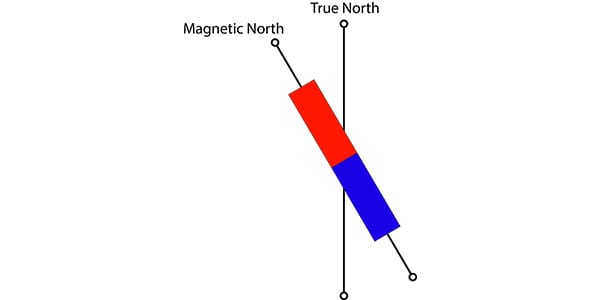
Across most of the earth, there is a separation between the direction of true north and magnetic north, as illustrated in the diagram above. The angle formed is known as variation.
The amount of variation changes across the surface of the earth. In some locations, there will be zero variation, while in other locations there will be many degrees.
It is, therefore, vital that you know the variation at your location so that you can apply it correctly.
Variation Is Found On A Compass Rose
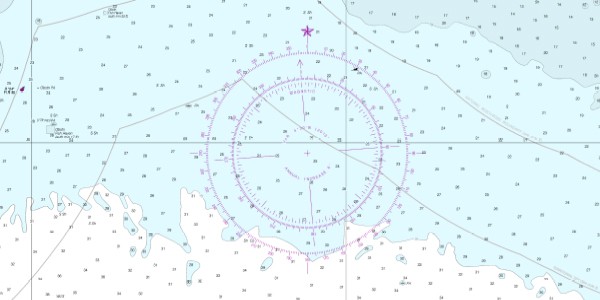
The easiest way to determine variation at your location is to look at the compass rose on a nautical chart.
In the image above, you can see the variation illustrated graphically with the arrow pointing slightly to the west of true north.
Further detail can be found in the middle of the compass rose, which in this case says:
VAR 4° 40’ W (2015)
ANNUAL INCREASE 6’
It gives us a precise value of variation for a particular year and tells us how to adapt it to give variation in any other year.
The main caveat of using a compass rose is that you should always use the rose located closest to your location. If you find yourself between two different compass roses, it is worth calculating variation at both to see if there is enough of a difference that you should interpolate in between.
Pro Tip: Remember that most vessels will only be able to steer to the closest degree, so there is no point interpolating if the difference is less than 1°.
Alternatively, most electronic navigational aids will also show you variation. You’ll be able to interrogate your electronic chart, or simply read it directly from your GPS screen.
Just make sure you know how to find it on your own navigational equipment.
What Is Deviation?
Annoyingly, a boat’s compass does not usually point towards the magnetic north pole.
The compass needle is deflected by local magnetic fields caused by metallic objects close by. It could be a tin of paint in a cupboard, the lead in your keel, or, if you are on a large ship, it could even be the cargo or the hull itself.
“Deviation is the difference between the direction your compass needle points, and the actual direction of the magnetic north pole. It is due to the fact that local magnetic fields, caused by metallic objects close to your compass, will push the compass needle away from the north magnetic pole.”
Casual Navigation
Deviation is specific to your vessel and will vary according to your boat’s heading.
Imagine the situation where your deviation is caused entirely by your boat’s massive metal anchor on your bow. As you steam along, your magnetic compass will want to point towards both the magnetic north pole and your anchor.
If you are steaming due north, both will be in the same direction so you can expect zero deviation.
If you steam east or west, however, you can expect the compass to point mainly towards the north magnetic pole, but you’ll also expect it to be pulled slightly towards the massive lump of metal at your bow.
The difference between the two is your deviation.
Deviation Is Found On A Compass Card
As deviation is specific to each vessel, it is only possible to find by assessing your vessel.
You can do it yourself by performing a compass swing, or you can employ a compass adjuster to do it for you.
No matter which you choose, the end result should be a deviation card, also known as a compass card.

The deviation card might show numerical values, similar to the table above, or it might show a graph, which has just been produced by plotting the values onto a curve.
No matter which you have, the deviation card gives you a value for deviation for different headings on your boat, which you can use when correcting your compass bearings.
Applying Deviation To Compass Bearings
We have already discussed that deviation is the difference between where your compass needle is pointing and the direction of magnetic north.

When deviation is west, it means that your compass needle settles to the west of magnetic north.
When deviation is east, it means that your compass needle settles to the east of magnetic north.
This is an incredibly important concept to understand so that you can apply the correction in the right direction.
Let’s focus on a westerly deviation to see how it works.
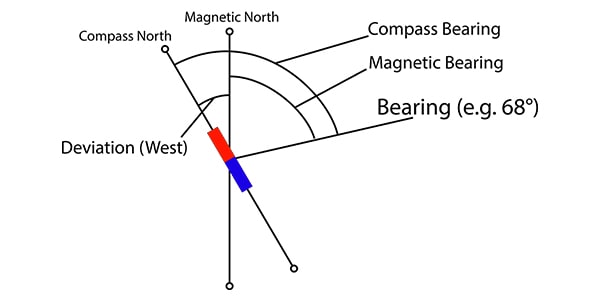
In the diagram above, you can see that I have added a bearing of 068°(M) to illustrate how the magnetic bearing and the compass bearing differ.
The bearing measures 68° from the magnetic north pole, but it measures 68° + Deviation from the compass needle.
When the deviation is west, you must add it to a magnetic bearing to turn it into a compass bearing.
This leads us to a simple rhyme that helps to remember it:
“Deviation west, compass best”
Meaning that when the deviation is west, the compass bearing is going to be numerically higher than the magnetic bearing. Similarly,
“Deviation east, compass least”
When the deviation is the other way around, the compass bearing is going to be numerically less than the magnetic bearing.
Applying Variation To Magnetic Compass Bearings
Similar to what I have just explained with the deviation in the previous section, the easiest way to understand how to apply variation is to picture it.

In the absence of any deviation, variation is the difference between your compass, pointing at the magnetic north pole, and the direction of true north.
When the variation is west, it means that the magnetic north pole is to the west of the true north pole.
When the variation is east, it means that the magnetic north pole is to the east of the true north pole.
Again, we can focus on just the westerly variation to see how to apply it.
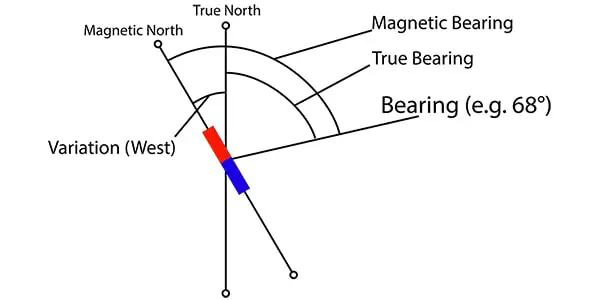
Measuring a bearing of 068°(T), you will need to add on a westerly variation to turn it into a magnetic bearing.
“Variation west, magnetic best”
Or you can apply it the other way around. If the variation is east, you take it away from a true bearing to get a magnetic mearing.
“Variation east, magnetic least”
Of course, applying variation and deviation separately is only part of the story. In reality, you need to apply them in a chain to be able to correct your compass readings to be true.
Correcting Compass Bearings To True Bearings
When correcting a bearing from your compass and turning it into a true bearing, we need to chain together the corrections of deviation and variation that we have already discussed.

Starting from our compass bearing, we apply deviation to get a magnetic bearing. We then apply variation to the magnetic bearing to turn it into a true bearing.
You can do it diagrammatically as I demonstrated previously, or you can use another mnemonic as a shortcut.
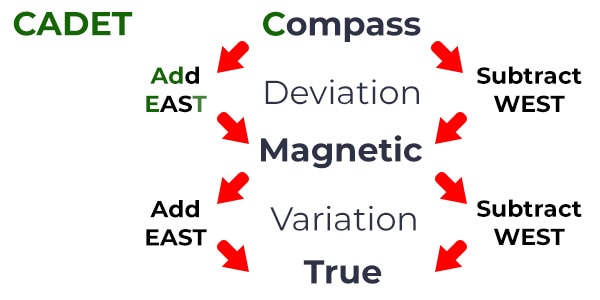
You first construct the order of the words using the mnemonic “Cadbury Dairy Milk Very Tasty”, then you use the word “Cadet” to see whether you add or subtract.
C-ad-et
Compass – add – east
Very quickly you can construct the full cheat sheet for yourself and you’ll be sure that you will apply all the corrections in the correct order.
Personally, I prefer to do it diagrammatically and work it out every time, but the choice is yours.
Worked Example: Correcting A Compass Bearing
If we take the example that we have the following starting information:
Compass bearing: 070°(C)
Deviation 4°E
Variation 2°W
You can assume that you have read the bearing from your compass, you got the variation from your chart and your deviation from your compass card.
We then construct a blank table to get started, using the mnemonic.
| Compass (C) | C | Cadbury |
| Deviation | D | Dairy |
| Magnetic (M) | M | Milk |
| Variation | V | Very |
| True (T) | T | Tasty |
Next, we can simplify the table and add our starting values.
| C | 070°(C) |
| D | 4° E |
| M | |
| V | 2° W |
| T |
Next, we need to work out whether to add or subtract the deviation from the compass reading. In this case, the mnemonic “Cadet” tells us to “add east”.
Similarly, the rhyme “deviation east, compass least” tells us that the compass bearing is going to be less than the magnetic bearing, meaning we should add it on.
| C | 070°(C) |
| D | 4° E |
| M | 074° (M) |
| V | 2° W |
| T |
Next, we need to determine whether we add or subtract the variation.
As we added an easterly deviation, it implies that we’ll need to subtract the westerly variation.
| C | 070°(C) |
| D | 4° E |
| M | 074° (M) |
| V | 2° W |
| T | 072° (T) |
It works, the same going up the table. For example, if you started with the true bearing and wanted to find out the compass bearing.
You would just need to add the westerly variation and subtract the easterly deviation.
Pro Tip: I prefer using the diagrams rather than the mnemonics because it means that I’ll always do things correctly, no matter whether I am travelling up or down the tables.
